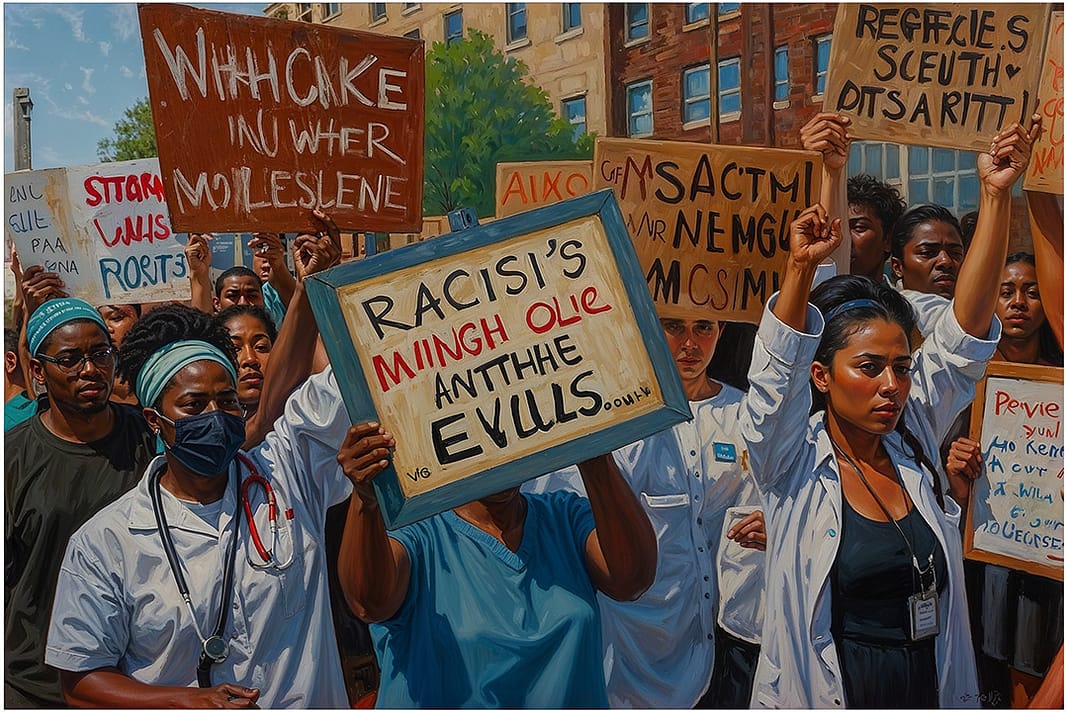The body, a sacred vessel, bears the weight of history. For some, it is light, gentle with the privilege of care, while for others, it is a battleground, scarred by the sins of those who have forgotten how to see its humanity. When you walk into a doctor’s office—whether as a child writhing in pain, or a mother laboring to bring life forth—you expect care. You expect healing. But what if the body that holds your pain is one that this world has been trained not to believe?
In the halls of hospitals, where the sterile smell of antiseptic meets the murmur of nurses and doctors tending to the fragile spaces between life and death, there exists a haunting silence. It is the silence of disbelief, an unspoken denial that some bodies do not hurt the way others do. This is the story of Black bodies in American medicine—bodies that are too often disbelieved, dismissed, and discarded.
The numbers—they weigh heavy. Fifty percent of medical students and residents believe that Black people feel less pain than their white counterparts. Imagine that. Imagine the weight of pain that is felt but never fully acknowledged, never fully seen, because somewhere, deep in the recesses of the mind, a lie has taken root—a lie that Black skin, thick as it might be perceived, does not hurt as white skin does.
This is not just ignorance. It is the legacy of a twisted science that goes back to the days when Black people were chained and sold, when doctors like J. Marion Sims experimented on Black women without anesthesia, convinced they could withstand it. These lies—these myths—are still breathing today. They show up in the hands of doctors who prescribe fewer painkillers to Black patients or none at all. They manifest in the emergency rooms where Black children with appendicitis are left without the relief of opioids, where their white peers are medicated in comparison. Twelve percent of Black children receive opioids; thirty-three percent of white children are granted the same.
“How could this still be?” You might ask. And it is a question that trembles with the frustration of centuries. The answer lies not in the bodies themselves, but in the minds of those who control the care. Racism, once justified by pseudo-scientific myths of biological differences, is now woven into the very fabric of the medical system. It lives in the shadows of the unconscious, in the implicit biases of well-meaning doctors and nurses who, without even realizing it, treat Black patients as though they feel less, as though their suffering is somehow less urgent, less real.
And yet, this is the reality. These biases—small, unnoticed, festering—cost lives. Black women in childbirth are three to four times more likely to die than their white counterparts. It is not because their bodies are weaker, nor because their biology is any different. It is because the pain in their voices is dismissed. Their cries for help, too often unheard. Serena Williams, one of the greatest athletes of our time, almost died after giving birth. Her doctors ignored her when she described the blood clots she knew were forming in her body. If this could happen to her—someone with the resources and voice to advocate for herself—imagine what happens to those who do not have that power.
But how did we get here? How does this happen in a country that calls itself modern, in a system that prides itself on innovation and advancement? It happens because racism is not just a word, it is a structure. It is embedded in the policies and practices that govern our institutions, in the way hospitals are funded, in the way medical students are taught.
Consider this: many medical schools still perpetuate the myth that there are inherent biological differences between Black and white people. They might teach that Black people have denser bones, thicker skin, or less sensitivity to pain, reinforcing the very biases that lead to inequitable care. But the truth is that these differences are not rooted in biology—they are rooted in history, in the social and economic conditions that have been created by centuries of oppression. Redlining—a practice that once forced Black families into the poorest neighborhoods—has left a legacy of underfunded hospitals and clinics in predominantly Black areas. The result? Many Black people live miles away from quality healthcare, and even when they do have access, they are treated as though they do not deserve it.
There are efforts being made to change this. We see the rise of implicit bias training for healthcare providers, policies like California’s mandate for bias training in perinatal care, and the increased focus on cultural competence in medical education. But training alone will not undo centuries of harm. It is one step, and the path ahead is long.
What if the system itself needs to be dismantled? What if the very foundation on which it stands is broken?
There are federally qualified health centers—nonprofit clinics that provide care to underserved communities, places where Black and brown patients can receive affordable treatment. And yet, even these centers are a patchwork solution to a much larger problem. There are initiatives to bring mobile clinics into Black neighborhoods, where hospitals have long since closed their doors. There are community health workers—people who understand the needs of their communities because they are part of them—working to bridge the gap between patients and providers.
But these are bandages on a wound that requires something far more radical. We need policies that ensure healthcare is a human right, that make it impossible for a child to be denied pain medication simply because they are Black. We need to invest in diversifying the medical field, because when Black patients see Black doctors, studies show they receive better care. We need to empower health equity task forces to reshape the very structures of healthcare, not just react to the crises that racism creates.
And we need to ask ourselves the hard questions, not just as individuals, but as a society. How early do these biases begin? Children as young as five are already being conditioned to see Black people as more capable of enduring pain. The messages are subtle, embedded in the media they consume, in the words they hear, in the silences that follow when a Black child falls and is told to “shake it off.”
So, where does the healing begin? It begins with recognizing the wound. It begins with reckoning with the fact that for centuries, Black bodies have been seen as objects, as tools, as less human. It begins with tearing down the false beliefs that have allowed this system to thrive.
We can no longer allow the myths to persist. Black bodies feel pain. Black bodies deserve care. And until that truth becomes the foundation of our medical system, we will continue to fail not just Black people, but our shared humanity.
And as we reflect on the weight of these truths, we must ask ourselves: When will we choose to stop? When will we choose to believe in the dignity and worth of every body, no matter the color of its skin?
The answer to that question is not just in the hands of policymakers or doctors—it is in all of us. Because healing, true healing, requires that we look into the heart of our collective consciousness and confront the lies we’ve been told. It requires us to believe the pain that is spoken and to respond with the compassion that all bodies, all souls, deserve.
Discover more from The Reasoned Journey
Subscribe to get the latest posts sent to your email.


